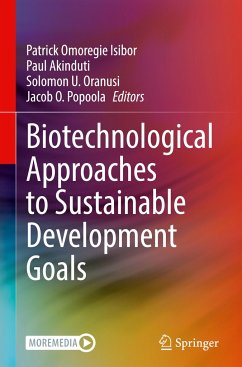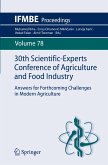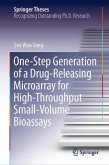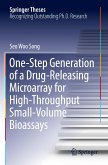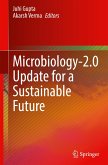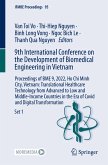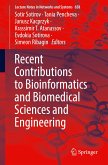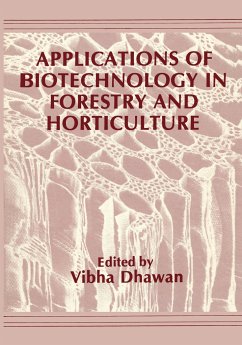Biotechnological Approaches to Sustainable Development Goals
Herausgegeben:Isibor, Patrick Omoregie; Akinduti, Paul; Oranusi, Solomon U.; Popoola, Jacob O.
Biotechnological Approaches to Sustainable Development Goals
Herausgegeben:Isibor, Patrick Omoregie; Akinduti, Paul; Oranusi, Solomon U.; Popoola, Jacob O.
- Gebundenes Buch
- Merkliste
- Auf die Merkliste
- Bewerten Bewerten
- Teilen
- Produkt teilen
- Produkterinnerung
- Produkterinnerung
Biotechnological Approaches to Sustainable Development Goals presents selected contributions from the 2022 International Biotechnology Conference Exhibition and Workshop (IBCEW) that cover techniques, current trends, and cutting-edge biotechnological tools for achieving sustainable development goals (SDGs). The authors explore recent advances that solve challenges related to sustainable agriculture, climate change, prevention and control of pandemics, biotechnology for a sustainable economy, and biotechnological industries and SDGs. The IBCEW aims to share knowledge, experiences, and ideas…mehr
Andere Kunden interessierten sich auch für
![30th Scientific-Experts Conference of Agriculture and Food Industry 30th Scientific-Experts Conference of Agriculture and Food Industry]() 30th Scientific-Experts Conference of Agriculture and Food Industry149,99 €
30th Scientific-Experts Conference of Agriculture and Food Industry149,99 €![One-Step Generation of a Drug-Releasing Microarray for High-Throughput Small-Volume Bioassays One-Step Generation of a Drug-Releasing Microarray for High-Throughput Small-Volume Bioassays]() Seo Woo SongOne-Step Generation of a Drug-Releasing Microarray for High-Throughput Small-Volume Bioassays75,99 €
Seo Woo SongOne-Step Generation of a Drug-Releasing Microarray for High-Throughput Small-Volume Bioassays75,99 €![One-Step Generation of a Drug-Releasing Microarray for High-Throughput Small-Volume Bioassays One-Step Generation of a Drug-Releasing Microarray for High-Throughput Small-Volume Bioassays]() Seo Woo SongOne-Step Generation of a Drug-Releasing Microarray for High-Throughput Small-Volume Bioassays75,99 €
Seo Woo SongOne-Step Generation of a Drug-Releasing Microarray for High-Throughput Small-Volume Bioassays75,99 €![Microbiology-2.0 Update for a Sustainable Future Microbiology-2.0 Update for a Sustainable Future]() Microbiology-2.0 Update for a Sustainable Future134,99 €
Microbiology-2.0 Update for a Sustainable Future134,99 €![9th International Conference on the Development of Biomedical Engineering in Vietnam 9th International Conference on the Development of Biomedical Engineering in Vietnam]() 9th International Conference on the Development of Biomedical Engineering in Vietnam186,99 €
9th International Conference on the Development of Biomedical Engineering in Vietnam186,99 €![Recent Contributions to Bioinformatics and Biomedical Sciences and Engineering Recent Contributions to Bioinformatics and Biomedical Sciences and Engineering]() Recent Contributions to Bioinformatics and Biomedical Sciences and Engineering127,99 €
Recent Contributions to Bioinformatics and Biomedical Sciences and Engineering127,99 €![Applications of Biotechnology in Forestry and Horticulture Applications of Biotechnology in Forestry and Horticulture]() Applications of Biotechnology in Forestry and Horticulture38,99 €
Applications of Biotechnology in Forestry and Horticulture38,99 €-
-
-
Biotechnological Approaches to Sustainable Development Goals presents selected contributions from the 2022 International Biotechnology Conference Exhibition and Workshop (IBCEW) that cover techniques, current trends, and cutting-edge biotechnological tools for achieving sustainable development goals (SDGs). The authors explore recent advances that solve challenges related to sustainable agriculture, climate change, prevention and control of pandemics, biotechnology for a sustainable economy, and biotechnological industries and SDGs. The IBCEW aims to share knowledge, experiences, and ideas among scientists, academics, students, industry representatives, and other professionals interested in biotechnology and attaining SDGs for development in Nigeria, Africa, and globally.
Produktdetails
- Produktdetails
- Verlag: Springer / Springer Nature Switzerland / Springer, Berlin
- Artikelnr. des Verlages: 978-3-031-33369-9
- 2023
- Seitenzahl: 340
- Erscheinungstermin: 30. Juli 2023
- Englisch
- Abmessung: 241mm x 160mm x 24mm
- Gewicht: 676g
- ISBN-13: 9783031333699
- ISBN-10: 3031333691
- Artikelnr.: 67793811
- Herstellerkennzeichnung Die Herstellerinformationen sind derzeit nicht verfügbar.
- Verlag: Springer / Springer Nature Switzerland / Springer, Berlin
- Artikelnr. des Verlages: 978-3-031-33369-9
- 2023
- Seitenzahl: 340
- Erscheinungstermin: 30. Juli 2023
- Englisch
- Abmessung: 241mm x 160mm x 24mm
- Gewicht: 676g
- ISBN-13: 9783031333699
- ISBN-10: 3031333691
- Artikelnr.: 67793811
- Herstellerkennzeichnung Die Herstellerinformationen sind derzeit nicht verfügbar.
Dr. Patrick Omoregie Isibor is currently a Lecturer in the Department of Biological Sciences at Covenant University. He received his Ph.D. and M.Sc. in Environmental Quality Management from the University of Benin and a B.Sc. in Zoology from Ambrose Alli University. Dr. Isibor's research interests include ecotoxicology, hydrobiology, bioaccumulation, biosequestration, biodiversity conservation, and aquatic ecology. He is a member of the Association for Environmental Impact Assessment of Nigeria (AEIAN), the International Association of Risk and Compliance Professionals (IARCP), and the African Society for Toxicological Sciences (ASTS). He is an Editor for the African Journal of Health, Safety, and Environment and a reviewer for several reputable international journals. Dr. Paul Akinduti is a Lecturer and researcher with the Microbiology Unit of the Department of Biological Sciences at Covenant University. He received his Ph.D. in Medical Microbiology and Bacteriologyfrom Olabisi Onabanjo University. He is a Fellow of the Medical Laboratory Science Council of Nigeria and a recipient of the World Academy of Sciences and Bill and Melinda Gates Foundation Travel Awards. Dr. Akinduti's areas of research interest include antimicrobial agents, antimicrobial resistance, molecular biology, bacterial pathogenesis, antimicrobial susceptibility testing, bacterial antibiotic resistance, bacteriology, antibacterial activity, bacterial drug resistance, diagnostic microbiology, molecular bacteriology, molecular microbiology, foodborne diseases, molecular typing, microbial genetics, bacterial toxins, bacterial conjugation, and pathogenesis. Prof. Solomon Oranusi is a Professor of Microbiology at Covenant University, where he has also served as Sub-Dean of the School of Postgraduate Studies. Prof. Solomon holds a B.Sc degree in microbiology from the University of Nigeria Nsukka (UNN) and an M. Sc and Ph.D. in microbiology from Ahmadu Bello University (ABU) Zaria. He is a Fellow of the Institute of Medical Laboratory Science Council of Nigeria and a Public Analyst with MIPAN. His research interests include biogas and digestate bio-fertilizer production from food and agricultural wastes (waste-to-wealth), food safety, HACCP, and public and environmental health. Professor Oranusi is a member of several academic and professional organizations, including the Institute of Public Analysts of Nigeria (IPAN), the Association of Industrial Microbiologists of Nigeria (AIMN), the Nigerian Institute of Food Science and Technology (NIFST), the Institute of Medical Laboratory Sciences of Nigeria (IMLSN), and the American Society for Microbiology (ASM). He has published more than 130 peer-reviewed scientific articles and is a reviewer for several international journals. He has served as an examiner for postgraduate theses and dissertations and as an assessor for the promotion of applicants to the professorial cadre of academic institutions. Dr. Jacob Popoola is an Associate Professor of Pure and Applied Biology at Bowen University. He was previously a researcher and Senior Lecturer in the Department of Biological Sciences at Covenant University, where he conducted research in applied ethnobotany, plant genetics, and molecular biology. Dr. Popoola received his Ph.D. in Biology (Plant Genetics and Biotechnology) from Covenant University. His current projects include sequencing diversity of moringa oleifera towards genetic improvement, biosystematic studies of miscellaneous neglected underutilized legumes as future food security, and characterization of root and tubers for utilization.
Part 1: Food and sustainable agriculture.- Chapter 1. Mycotoxin Occurrence and Risk Assessment in Infants and Young Children (IYC) Formulated Foods in Southwest Nigeria.- Chapter 2. In vitro antifungal activity of Bauhinia monandra (kurz) leaf extracts against fungal pathogens isolated from spoilt Musa paradisiaca l.- Chapter 3. Effect of Aspergillus fumigatus MT899185 phytase addition on the nutritional and phytate content of formulated cowpea-based poultry feed.- Chapter 4. Histology, Condition Factor, and DNA Analysis of Clarias gariepinus (Burchell, 1822) Exposed to MC-LR.- Chapter 5. Morphological trait variation and correlation analysis in landraces of southern Nigerian fluted pumpkin (Telfairia occidentalis Hook. F.).- Part 2: Climate change and the environment.- Chapter 6. Comparative Analysis of the Trophic status, Length-Weight Relationship, Gastrosomatic Index and Bioaccumulation of Trace Metals in Wild and Captive Clarias gariepinus.- Chapter 7. Occurrence and Characteristics of Microplastics in the Surface Water and Sediment of Lagos Lagoon, Nigeria.- Chapter 8. Assessment of the Effectiveness of Chlorination for Drinking Water Treatment.- Part 3: Health pandemic and biotechnology.- Chapter 9. Lack of Association of CYP2C9:c.430C>T and SCN1A:c.3184A>G polymorphisms with Epilepsy risk or Drug-resistance in Childhood Epilepsy Syndromes in Lagos State, Nigeria.- Chapter 10. Computational Approaches Towards Prevention And Surveillance of Lassa Fever In Developing Countries.- Chapter 11. Antibacterial Efficacy of Thymus vulgaris Essential Oil Against Extended Spectrum Betalactamase - Producing Escherichia Coli In Urinary Tract Infections.- Chapter 12. Antibacterial efficacy of Syzygium aromaticum essential oil against extended spectrum Betalactamase -producing Escherichia Coli in urinary tract infections.- Chapter 13. Growth And Haemato-Biochemical Responses Of All-Male Tilapia, Oreochromis niloticus To Diets Containing Fermented Cassava Leaf Meal.- Chapter 14. Implication of age-demography of Mycobacterium tuberculosis infection among HIV seropositive and seronegative individuals.- Chapter 15. Comparative phytochemical contents and antioxidant activities of Tapinanthus cordifolius and Irvingia wombolu leaf extracts.- Chapter 16. The central metabolism model of Anopheles gambiae: a tool for understanding malaria vector biology.- Part 4: Biotechnology For Sustainable Economy.- Chapter 17. Plant Microbiome Engineering: Principles, Methods, and Current Trends.- Chapter 18. Water Purification Potentials of Crustacean Chitosan.- Part 5: Industrial Biotechnology and SDGS.- Chapter 19. Omics and Mutagenesis: Molecular Optimization Strategies For Strain Improvement In Biosurfactants Production.- Chapter 20. Comparison Of Two Extraction Methods To Obtain Quality Genomic DNA From Eggplants (Solanum Sp.).
Part 1: Food and sustainable agriculture.- Chapter 1. Mycotoxin Occurrence and Risk Assessment in Infants and Young Children (IYC) Formulated Foods in Southwest Nigeria.- Chapter 2. In vitro antifungal activity of Bauhinia monandra (kurz) leaf extracts against fungal pathogens isolated from spoilt Musa paradisiaca l.- Chapter 3. Effect of Aspergillus fumigatus MT899185 phytase addition on the nutritional and phytate content of formulated cowpea-based poultry feed.- Chapter 4. Histology, Condition Factor, and DNA Analysis of Clarias gariepinus (Burchell, 1822) Exposed to MC-LR.- Chapter 5. Morphological trait variation and correlation analysis in landraces of southern Nigerian fluted pumpkin (Telfairia occidentalis Hook. F.).- Part 2: Climate change and the environment.- Chapter 6. Comparative Analysis of the Trophic status, Length-Weight Relationship, Gastrosomatic Index and Bioaccumulation of Trace Metals in Wild and Captive Clarias gariepinus.- Chapter 7. Occurrence and Characteristics of Microplastics in the Surface Water and Sediment of Lagos Lagoon, Nigeria.- Chapter 8. Assessment of the Effectiveness of Chlorination for Drinking Water Treatment.- Part 3: Health pandemic and biotechnology.- Chapter 9. Lack of Association of CYP2C9:c.430C>T and SCN1A:c.3184A>G polymorphisms with Epilepsy risk or Drug-resistance in Childhood Epilepsy Syndromes in Lagos State, Nigeria.- Chapter 10. Computational Approaches Towards Prevention And Surveillance of Lassa Fever In Developing Countries.- Chapter 11. Antibacterial Efficacy of Thymus vulgaris Essential Oil Against Extended Spectrum Betalactamase - Producing Escherichia Coli In Urinary Tract Infections.- Chapter 12. Antibacterial efficacy of Syzygium aromaticum essential oil against extended spectrum Betalactamase -producing Escherichia Coli in urinary tract infections.- Chapter 13. Growth And Haemato-Biochemical Responses Of All-Male Tilapia, Oreochromis niloticus To Diets Containing Fermented Cassava Leaf Meal.- Chapter 14. Implication of age-demography of Mycobacterium tuberculosis infection among HIV seropositive and seronegative individuals.- Chapter 15. Comparative phytochemical contents and antioxidant activities of Tapinanthus cordifolius and Irvingia wombolu leaf extracts.- Chapter 16. The central metabolism model of Anopheles gambiae: a tool for understanding malaria vector biology.- Part 4: Biotechnology For Sustainable Economy.- Chapter 17. Plant Microbiome Engineering: Principles, Methods, and Current Trends.- Chapter 18. Water Purification Potentials of Crustacean Chitosan.- Part 5: Industrial Biotechnology and SDGS.- Chapter 19. Omics and Mutagenesis: Molecular Optimization Strategies For Strain Improvement In Biosurfactants Production.- Chapter 20. Comparison Of Two Extraction Methods To Obtain Quality Genomic DNA From Eggplants (Solanum Sp.).

